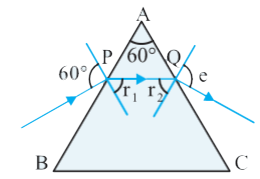A ray of light is incident on one face of a transparent slab of thickness 15 cm. The angle of incidence is 60∘. If the lateral displacement of the ray on emerging from the parallel plane is 5√3 cm, the refractive index of the material of the slab is
1.414
1.532
1.732
None of these
The correct Answer is:C
To solve the problem, we will follow these steps:
Step 1: Understand the given data
- Thickness of the slab (t) = 15 cm
- Angle of incidence (i) = 60°
- Lateral displacement (x) = 5√3 cm
Step 2: Use the formula for lateral displacement
The formula for lateral displacement (x) is given by:
x=t⋅sin(i−r)cos(r)
where r is the angle of refraction.
Step 3: Rearrange the formula
We can rearrange the formula to solve for sin(i−r):
x⋅cos(r)=t⋅sin(i−r)
Thus,
sin(i−r)=x⋅cos(r)t
Step 4: Substitute the known values
Substituting the known values into the equation:
5√3⋅cos(r)=15⋅sin(60°−r)
We know that sin(60°)=√32.
Step 5: Calculate sin(60°−r)
Using the sine subtraction formula:
sin(60°−r)=sin(60°)cos(r)−cos(60°)sin(r)
Substituting the known values:
sin(60°−r)=√32cos(r)−12sin(r)
Step 6: Set up the equation
Now we can set up the equation:
5√3⋅cos(r)=15(√32cos(r)−12sin(r))
Step 7: Simplify the equation
Expanding the right side:
5√3⋅cos(r)=15√32cos(r)−152sin(r)
Rearranging gives:
5√3⋅cos(r)−15√32cos(r)=−152sin(r)
Step 8: Combine like terms
Combining the terms on the left side:
(5√3−15√32)cos(r)=−152sin(r)
Calculating the left side:
(10√32−15√32)cos(r)=−152sin(r)
This simplifies to:
−5√32cos(r)=−152sin(r)
Step 9: Solve for tan(r)
Dividing both sides by −52:
√3cos(r)=3sin(r)
Thus:
tan(r)=√33=1√3
This implies:
r=30°
Step 10: Calculate the refractive index
Using Snell's law:
n=sin(i)sin(r)=sin(60°)sin(30°)
Substituting the known values:
n=√3212=√3≈1.732
Final Answer
The refractive index of the material of the slab is approximately 1.732.
---
- Thickness of the slab (t) = 15 cm
- Angle of incidence (i) = 60°
- Lateral displacement (x) = 5√3 cm
The formula for lateral displacement (x) is given by:
x=t⋅sin(i−r)cos(r)
where r is the angle of refraction.
We can rearrange the formula to solve for sin(i−r):
x⋅cos(r)=t⋅sin(i−r)
Thus,
sin(i−r)=x⋅cos(r)t
Substituting the known values into the equation:
5√3⋅cos(r)=15⋅sin(60°−r)
We know that sin(60°)=√32.
Using the sine subtraction formula:
sin(60°−r)=sin(60°)cos(r)−cos(60°)sin(r)
Substituting the known values:
sin(60°−r)=√32cos(r)−12sin(r)
Now we can set up the equation:
5√3⋅cos(r)=15(√32cos(r)−12sin(r))
Expanding the right side:
5√3⋅cos(r)=15√32cos(r)−152sin(r)
Rearranging gives:
5√3⋅cos(r)−15√32cos(r)=−152sin(r)
Combining the terms on the left side:
(5√3−15√32)cos(r)=−152sin(r)
Calculating the left side:
(10√32−15√32)cos(r)=−152sin(r)
This simplifies to:
−5√32cos(r)=−152sin(r)
Dividing both sides by −52:
√3cos(r)=3sin(r)
Thus:
tan(r)=√33=1√3
This implies:
r=30°
Using Snell's law:
n=sin(i)sin(r)=sin(60°)sin(30°)
Substituting the known values:
n=√3212=√3≈1.732
The refractive index of the material of the slab is approximately 1.732.
Topper's Solved these Questions
- GEOMETRICAL OPTICSBOOK - AAKASH SERIESCHAPTER - GEOMETRICAL OPTICSEXERCISE - ADDITIONAL PRACTICE EXERCISE -I (LEVEL-II LECTURE SHEET (ADVANCED) MORE THAN ONE CORRECT TYPE QUESTIONS)
3 Videos
- GEOMETRICAL OPTICSBOOK - AAKASH SERIESCHAPTER - GEOMETRICAL OPTICSEXERCISE - ADDITIONAL PRACTICE EXERCISE -I (LEVEL-II LECTURE SHEET (ADVANCED) LINKED COMPREHENSION TYPE QUESTIONS)
8 Videos
- GEOMETRICAL OPTICSBOOK - AAKASH SERIESCHAPTER - GEOMETRICAL OPTICSEXERCISE - ADDITIONAL PRACTICE EXERCISE -I (LEVEL-I(MAIN) STRAIGHT OBJECTIVE TYPE QUESTIONS)
21 Videos
- ELEMENTS OF VECTORSBOOK - AAKASH SERIESCHAPTER - ELEMENTS OF VECTORSEXERCISE - QUESTIONS FOR DESCRIPTIVE ANSWERS
10 Videos
- LAWS OF MOTIONBOOK - AAKASH SERIESCHAPTER - LAWS OF MOTIONEXERCISE - PRACTICE EXERCISE
106 Videos
Similar Questions
A ray of light is incident on one face of a transparent glass slab of thickness 9cm at an angle of incidence 60∘. Lateral displacement of the ray on emerging from the opposite parallel face is 3√3cm. Refractive index of the material of slab is:
View SolutionA ray of light is incident on a parallel slab of thickness t and refractive index n. If the angle of incidence θ is small, than the lateral displacement in the incident and emergent ray will be
View SolutionA ray of light is incident at an angle of 60∘ on one face of a prism which has refracting angle of 30∘ . The ray emerging out of the prism makes an angle of 30∘ with the incident ray. If the refractive index of the material of the prism is μ=√a , find the value of a .
View SolutionA ray of light is incident on the surface of a glass plate of refractive index √3 at the polarising angle . The angle of incidence and angle of refraction of the ray is
View SolutionWhen a ray of light is incident normally on one refracting surface of an equilateral prism (Refractive index of the material of the prism =1.5
View SolutionA light ray is incident on a transparent slab of refractive index μ=√2 at an angle of incidence π/4. Find the ratio of the lateral displacement suffered by the light ray to the maximum value which it could have suffered.
View SolutionA ray of light is incident on one face of a prism (m=√3) at an angle of 60∘. The refracting angle of the prism is also 60∘. Find the angle of emergence .

View SolutionA ray of light is incident perpendicularly on a glass slab. The angle of incidence is 900.
View SolutionWhen a ray of light is incident normally on one refracting surface of an equilateral prism (Refractive index of the material of the prism =1.5)
View SolutionA ray of light is incident on the face AB of a glass prism ABC having vertex anlge A equal to 30∘. The face AC is silvered and a ray of light incident on the face AB retraces its path. If the refractive index of the material of prism is √3 find the angle of incidence on the face AB.
View Solution
